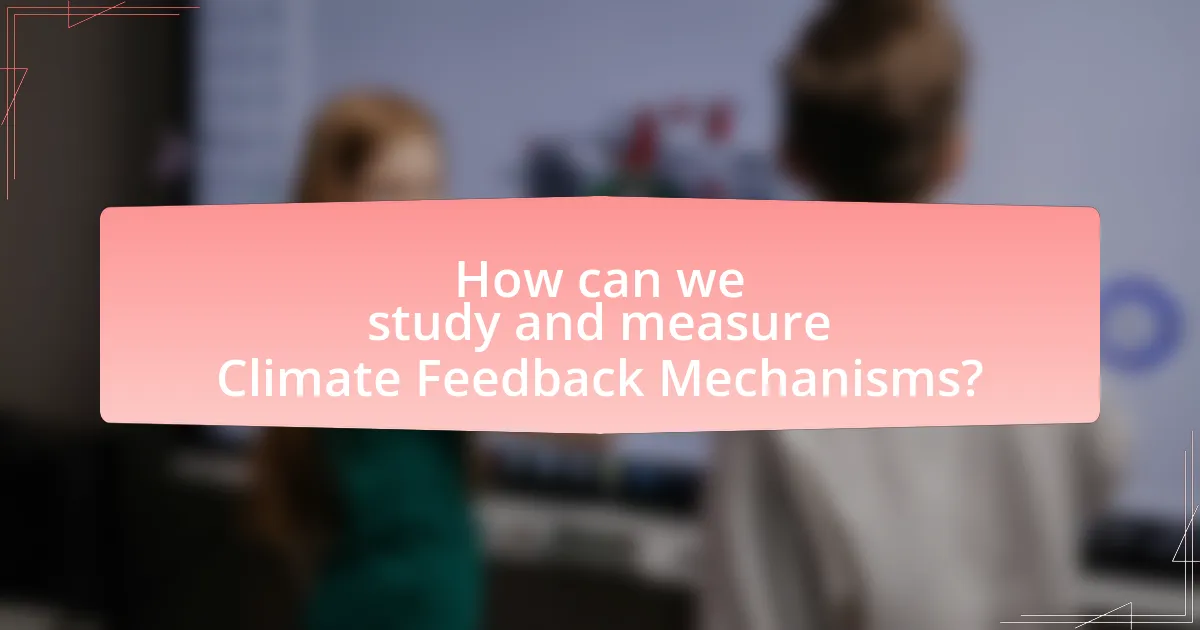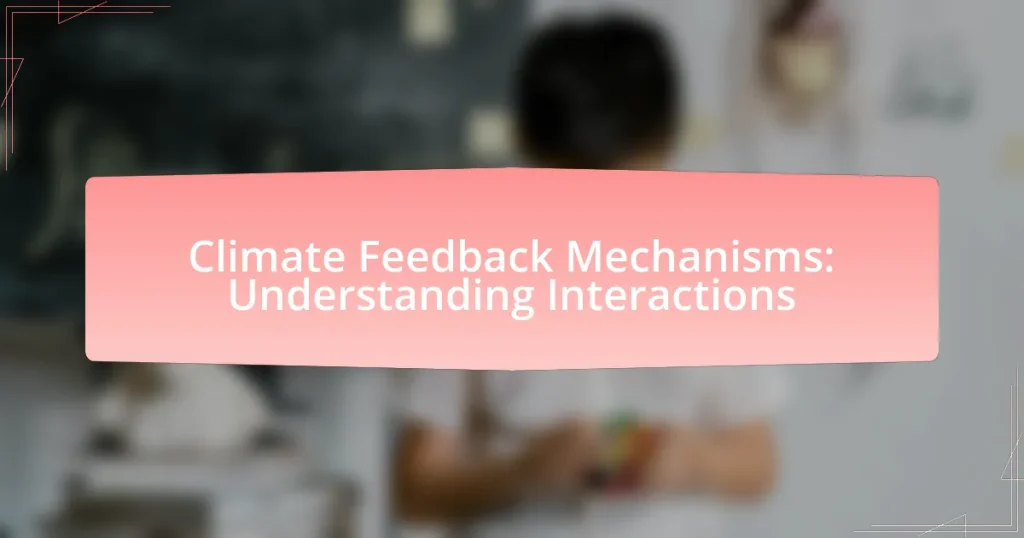Climate feedback mechanisms are processes that either amplify or diminish the effects of climate change, significantly influencing the Earth’s climate system. This article explores the primary types of feedback mechanisms, including positive and negative feedback, and their roles in climate dynamics, such as the ice-albedo and water vapor feedbacks. It discusses how these mechanisms impact global temperatures, ecosystems, and climate modeling, while also addressing the challenges in studying them and the uncertainties in current climate models. Additionally, the article highlights practical steps individuals and policymakers can take to mitigate the effects of these feedback mechanisms on climate change.

What are Climate Feedback Mechanisms?
Climate feedback mechanisms are processes that can amplify or diminish the effects of climate change. For example, when global temperatures rise, polar ice melts, reducing the Earth’s albedo, which leads to further warming as more solar energy is absorbed. This interaction illustrates how feedback mechanisms can create a cycle of increasing temperature and ice melt, demonstrating their significant role in climate dynamics.
How do Climate Feedback Mechanisms influence the Earth’s climate system?
Climate feedback mechanisms significantly influence the Earth’s climate system by amplifying or dampening the effects of climate change. For instance, the ice-albedo feedback occurs when melting ice reduces the Earth’s reflectivity, leading to increased absorption of solar energy and further warming. This process has been documented, showing that Arctic sea ice extent has decreased by about 40% since the late 1970s, contributing to accelerated warming in the region. Additionally, water vapor feedback enhances warming because warmer air holds more moisture, which is a potent greenhouse gas. Studies indicate that this feedback can increase the Earth’s temperature response to carbon dioxide emissions by approximately 50%. These mechanisms demonstrate how interconnected processes within the climate system can lead to significant changes in global temperatures and climate patterns.
What are the primary types of climate feedback mechanisms?
The primary types of climate feedback mechanisms are positive feedback and negative feedback. Positive feedback amplifies changes in the climate system, such as the melting of ice, which reduces the Earth’s albedo and leads to further warming. Negative feedback, on the other hand, counteracts changes, such as increased cloud cover that reflects sunlight and cools the surface. These mechanisms are critical in understanding climate dynamics, as they influence the rate and extent of climate change. For instance, the Intergovernmental Panel on Climate Change (IPCC) reports that positive feedbacks, like those associated with greenhouse gas emissions, can significantly accelerate global warming.
How do positive feedback mechanisms differ from negative feedback mechanisms?
Positive feedback mechanisms amplify changes in a system, while negative feedback mechanisms counteract changes to maintain stability. In climate systems, positive feedback can occur when melting ice reduces albedo, leading to increased solar absorption and further warming. Conversely, negative feedback is exemplified by increased cloud cover that reflects sunlight, thereby cooling the surface. These mechanisms are crucial in understanding climate interactions, as positive feedback can accelerate climate change, while negative feedback can help stabilize temperatures.
Why are Climate Feedback Mechanisms important for understanding climate change?
Climate feedback mechanisms are crucial for understanding climate change because they amplify or dampen the effects of initial climate changes, influencing the overall climate system. For instance, the melting of polar ice reduces the Earth’s albedo, leading to increased absorption of solar energy and further warming. This interaction illustrates how feedback mechanisms can accelerate climate change, making it essential to consider them in climate models and predictions. Research indicates that positive feedback loops, such as those involving water vapor and greenhouse gases, can significantly enhance warming trends, underscoring their importance in climate science.
What role do feedback mechanisms play in climate modeling?
Feedback mechanisms play a crucial role in climate modeling by influencing the climate system’s response to changes in temperature and other variables. These mechanisms can either amplify or dampen climate changes; for example, the ice-albedo feedback causes melting ice to reduce surface reflectivity, leading to further warming and more ice melt. This interaction is quantitatively significant, as studies indicate that feedbacks can contribute to a doubling of climate sensitivity estimates, which is critical for predicting future climate scenarios.
How can feedback mechanisms amplify or mitigate climate impacts?
Feedback mechanisms can amplify or mitigate climate impacts by influencing the rate and extent of climate change through various processes. For instance, positive feedback mechanisms, such as the melting of Arctic ice, reduce the Earth’s albedo effect, leading to increased solar absorption and further warming. This process has been documented, showing that as ice melts, more heat is absorbed by the ocean, accelerating temperature rise. Conversely, negative feedback mechanisms, like increased cloud cover from higher temperatures, can reflect sunlight and potentially cool the Earth. Research indicates that certain cloud types can enhance the Earth’s energy balance, thereby mitigating warming effects. These interactions illustrate how feedback mechanisms play a critical role in shaping climate dynamics.

What are the key examples of Climate Feedback Mechanisms?
Key examples of climate feedback mechanisms include the water vapor feedback, ice-albedo feedback, and carbon cycle feedback. Water vapor feedback occurs as the atmosphere warms, leading to increased water vapor, which enhances the greenhouse effect since water vapor is a potent greenhouse gas. Ice-albedo feedback involves the melting of ice and snow, which reduces the Earth’s albedo (reflectivity), causing more solar energy to be absorbed and further warming the planet. Carbon cycle feedback refers to the release of carbon dioxide and methane from natural sources, such as permafrost thawing, which exacerbates global warming. These mechanisms illustrate how changes in the climate system can amplify initial warming, demonstrating the interconnectedness of climate processes.
How does the water vapor feedback mechanism operate?
The water vapor feedback mechanism operates by amplifying the effects of climate change through the interaction of temperature and humidity. As global temperatures rise due to increased greenhouse gas emissions, the atmosphere can hold more water vapor, which is a potent greenhouse gas. This additional water vapor traps more heat, leading to further warming. Research indicates that for every 1°C increase in temperature, the atmosphere can hold approximately 7% more water vapor, significantly enhancing the greenhouse effect. This positive feedback loop continues to accelerate climate change, making it a critical factor in understanding climate dynamics.
What is the significance of water vapor in the atmosphere?
Water vapor is significant in the atmosphere as it acts as a greenhouse gas, contributing to the Earth’s energy balance and climate regulation. It absorbs and re-emits infrared radiation, which helps to trap heat in the atmosphere, thereby influencing global temperatures. According to the Intergovernmental Panel on Climate Change (IPCC), water vapor is responsible for approximately 50% of the greenhouse effect, making it a critical component in understanding climate feedback mechanisms. Additionally, water vapor plays a vital role in cloud formation and precipitation processes, further impacting weather patterns and climate systems.
How does increased temperature affect water vapor levels?
Increased temperature leads to higher water vapor levels in the atmosphere. This phenomenon occurs because warmer air can hold more moisture; specifically, for every 1°C increase in temperature, the capacity of air to hold water vapor increases by approximately 7%. This relationship is supported by the Clausius-Clapeyron equation, which describes how the saturation vapor pressure of water increases with temperature. As a result, higher temperatures contribute to an increase in humidity, which can amplify climate change effects through feedback mechanisms.
What is the role of ice-albedo feedback in climate change?
Ice-albedo feedback plays a critical role in climate change by amplifying warming effects. As global temperatures rise, ice and snow cover decrease, leading to a reduction in the Earth’s albedo, or reflectivity. This decrease allows more solar radiation to be absorbed by the Earth’s surface, further increasing temperatures and accelerating ice melt. For instance, research indicates that the Arctic has warmed at more than twice the global average rate, largely due to this feedback mechanism. The loss of reflective ice surfaces contributes to a cycle of warming that can lead to significant changes in climate patterns and ecosystems.
How does melting ice influence global temperatures?
Melting ice influences global temperatures by reducing the Earth’s albedo effect, which is the reflection of solar energy. When ice melts, it exposes darker ocean or land surfaces that absorb more sunlight, leading to increased warming. For instance, Arctic sea ice loss has been linked to a rise in global temperatures by approximately 0.5 degrees Celsius since the 1970s, as reported by the National Oceanic and Atmospheric Administration (NOAA). This feedback loop accelerates climate change, as higher temperatures lead to further ice melt, creating a cycle that exacerbates global warming.
What are the implications of reduced ice cover on ecosystems?
Reduced ice cover significantly impacts ecosystems by altering habitat availability and species interactions. The melting of ice reduces the habitat for polar species, such as seals and polar bears, which rely on ice for breeding and hunting. Additionally, decreased ice cover leads to increased sunlight penetration in aquatic environments, resulting in higher water temperatures and changes in phytoplankton growth patterns. This shift can disrupt food webs, as many marine species depend on phytoplankton as a primary food source. Furthermore, the loss of ice contributes to rising sea levels, which can inundate coastal habitats and affect biodiversity. Studies indicate that these changes can lead to a decline in species populations and shifts in community structures, ultimately threatening ecosystem stability.

How can we study and measure Climate Feedback Mechanisms?
To study and measure climate feedback mechanisms, researchers utilize a combination of observational data, climate models, and experimental approaches. Observational data from satellite measurements and ground-based sensors provide real-time insights into variables such as temperature, cloud cover, and greenhouse gas concentrations, which are essential for understanding feedback processes. Climate models simulate interactions between different components of the Earth system, allowing scientists to predict how changes in one element, like ice melt, can influence others, such as sea level rise or atmospheric circulation. Experimental approaches, including controlled laboratory studies and field experiments, help isolate specific feedback mechanisms, such as the impact of increased CO2 on plant growth and subsequent effects on carbon cycling. These methods collectively enhance our understanding of feedback loops, as evidenced by studies like the Coupled Model Intercomparison Project (CMIP), which has provided critical insights into climate sensitivity and feedback effects across various scenarios.
What methods are used to analyze feedback mechanisms in climate science?
Quantitative modeling, observational studies, and experimental approaches are the primary methods used to analyze feedback mechanisms in climate science. Quantitative modeling involves using computer simulations to predict climate responses to various factors, such as greenhouse gas emissions, which helps in understanding potential feedback loops. Observational studies collect real-world data on climate variables, allowing scientists to identify and quantify feedback effects, such as the albedo effect from melting ice. Experimental approaches, including controlled laboratory experiments, help isolate specific feedback mechanisms, providing insights into their dynamics. These methods collectively enhance the understanding of how feedback mechanisms influence climate change and its impacts.
How do satellite observations contribute to our understanding of feedback mechanisms?
Satellite observations enhance our understanding of feedback mechanisms by providing real-time data on climate variables such as temperature, cloud cover, and greenhouse gas concentrations. These observations allow scientists to analyze how changes in one component of the climate system can influence others, thereby revealing the interconnected nature of feedback loops. For instance, satellite data has shown that increased surface temperatures lead to reduced ice cover, which in turn decreases the Earth’s albedo, causing further warming. This specific feedback loop has been documented in studies like those from NASA’s Earth Observing System, which illustrate the critical role of satellite data in quantifying and modeling these interactions.
What role do climate models play in simulating feedback effects?
Climate models are essential for simulating feedback effects in the climate system by providing a framework to understand how various components interact and influence each other. These models incorporate physical laws and empirical data to predict how changes in one aspect of the climate, such as temperature, can lead to secondary effects, like changes in cloud cover or ice melt, which in turn affect the climate further. For instance, the Intergovernmental Panel on Climate Change (IPCC) reports that feedback mechanisms, such as the ice-albedo feedback, significantly amplify warming; as ice melts, less sunlight is reflected, leading to further warming and more ice melt. Thus, climate models are crucial for accurately forecasting future climate scenarios by quantifying these complex interactions and feedback loops.
What challenges exist in studying Climate Feedback Mechanisms?
Studying climate feedback mechanisms presents several challenges, primarily due to the complexity and interconnectivity of climate systems. These mechanisms involve intricate interactions between various components, such as the atmosphere, oceans, and land surfaces, making it difficult to isolate specific feedback effects. For instance, the feedback between temperature increases and water vapor levels is complicated by the varying responses of different regions and ecosystems. Additionally, the lack of comprehensive data and the limitations of current climate models hinder accurate predictions of feedback effects. Research indicates that uncertainties in climate sensitivity, which is the degree to which the climate system responds to greenhouse gas emissions, further complicate the understanding of these mechanisms.
How do uncertainties in data affect our understanding of feedback mechanisms?
Uncertainties in data significantly hinder our understanding of feedback mechanisms by introducing ambiguity in the relationships between variables. For instance, in climate science, inaccurate temperature measurements can lead to misinterpretations of how feedback loops, such as ice-albedo feedback, operate. Research indicates that uncertainties in climate models can result in a range of projected temperature increases, complicating the assessment of feedback strength and its implications for future climate scenarios. A study by Knutti and Sedláček (2012) highlights that uncertainties in climate sensitivity directly affect predictions of feedback mechanisms, emphasizing the need for precise data to improve our understanding of these complex interactions.
What are the limitations of current climate models in predicting feedback outcomes?
Current climate models face significant limitations in predicting feedback outcomes due to their inability to accurately represent complex interactions within the climate system. These models often simplify or overlook critical processes such as cloud formation, ocean circulation, and land-atmosphere interactions, which can lead to substantial errors in feedback predictions. For instance, the Intergovernmental Panel on Climate Change (IPCC) reports that uncertainties in cloud feedbacks can result in a range of climate sensitivity estimates, affecting projections of future warming by as much as 2 to 4 degrees Celsius. Additionally, many models struggle to incorporate the effects of human activities and natural variability adequately, further complicating their predictive capabilities.
What practical steps can be taken to address Climate Feedback Mechanisms?
To address climate feedback mechanisms, implementing strategies such as reducing greenhouse gas emissions, enhancing carbon sequestration, and promoting sustainable land use practices is essential. Reducing emissions can be achieved through transitioning to renewable energy sources, which accounted for 29% of global electricity generation in 2020, thereby decreasing the warming potential of the atmosphere. Enhancing carbon sequestration involves reforestation and afforestation efforts, which can absorb significant amounts of CO2; for instance, a study by the National Academy of Sciences estimates that reforestation could sequester up to 1.1 billion metric tons of CO2 annually in the U.S. Promoting sustainable land use practices, such as regenerative agriculture, can improve soil health and increase its carbon storage capacity, further mitigating feedback loops that exacerbate climate change.
How can policymakers incorporate feedback mechanisms into climate strategies?
Policymakers can incorporate feedback mechanisms into climate strategies by establishing systems for continuous data collection and analysis to assess the effectiveness of climate actions. These systems enable real-time monitoring of environmental changes and the impact of policies, allowing for timely adjustments based on observed outcomes. For instance, the integration of satellite data and climate modeling can provide insights into how specific strategies affect carbon emissions and ecosystem health. Research shows that adaptive management approaches, which rely on feedback loops, enhance resilience and effectiveness in climate policy implementation, as evidenced by successful programs in regions like California, where iterative assessments have led to improved air quality and reduced greenhouse gas emissions.
What actions can individuals take to mitigate the effects of feedback mechanisms?
Individuals can mitigate the effects of climate feedback mechanisms by reducing their carbon footprint through lifestyle changes. Actions include using public transportation, adopting energy-efficient appliances, and supporting renewable energy sources. For instance, a study by the International Energy Agency indicates that energy efficiency improvements could reduce global energy demand by 12% by 2040, significantly lowering greenhouse gas emissions. Additionally, individuals can engage in reforestation efforts and support sustainable agricultural practices, which enhance carbon sequestration and reduce the impact of feedback loops such as increased atmospheric CO2 leading to higher temperatures.


